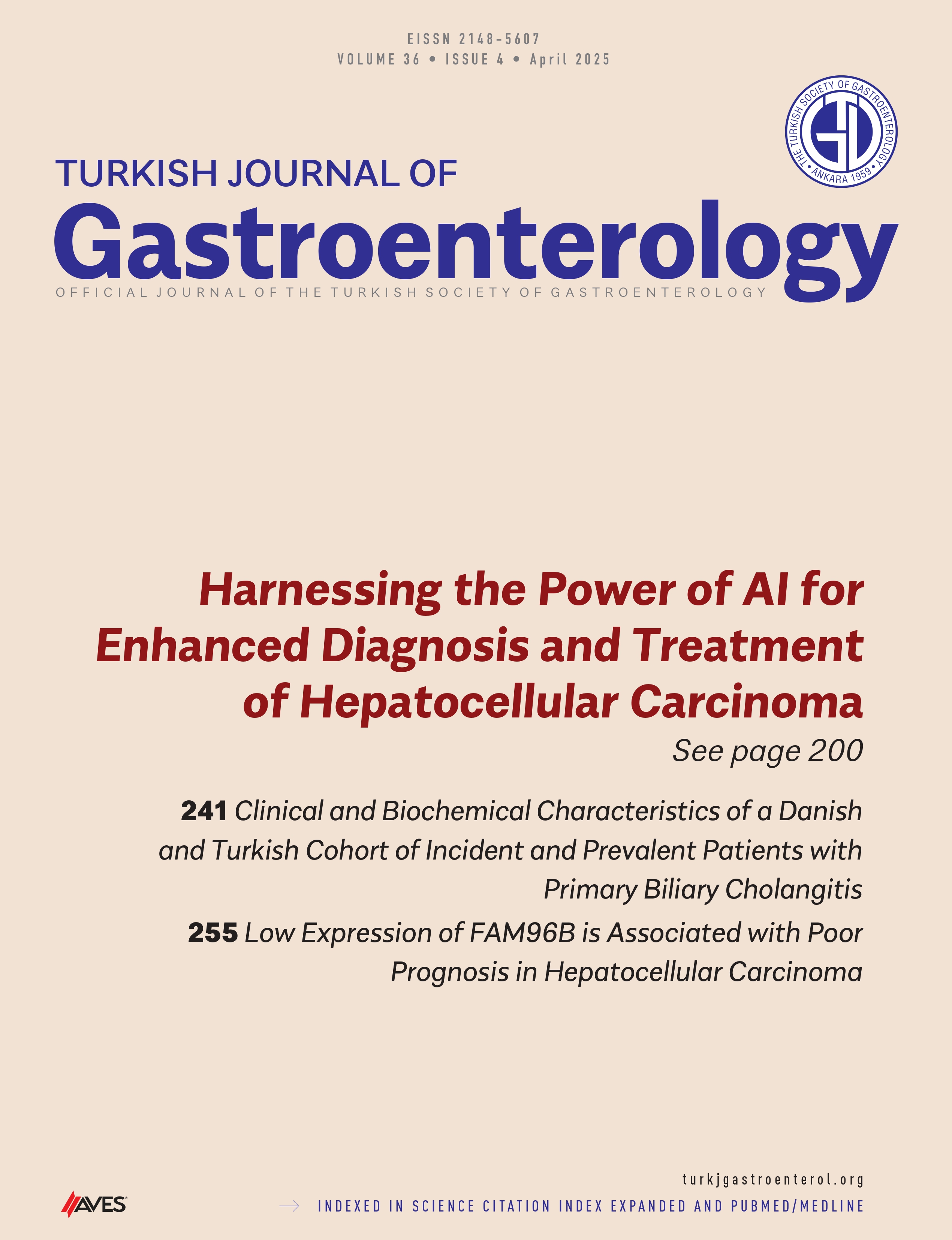Clinical and Biochemical Characteristics of a Danish and Turkish Cohort of Incident and Prevalent Patients with Primary Biliary Cholangitis
Main Article Content
Abstract
Background/Aims: Primary biliary cholangitis (PBC) is a chronic liver disease influenced by environmental, genetic, and epigenetic factors, with varying incidence across populations. This study compared demographic, biochemical, and treatment responses in Danish and Turkish PBC patients.
Materials and Methods: Four cohorts were analyzed: (1) 101 incident Turkish patients, (2) 77 incident Danish patients, (3) 103 prevalent Turkish patients, and (4) 155 prevalent Danish patients. Demographics, biochemical data, disease severity, and response to ursodeoxycholic acid (UDCA) were assessed. Regression analysis was applied to the entire cohort to identify factors associated with the UDCA response.
Results: Female dominance was noted in all cohorts (>90%) except the Danish incident group (75%). Turkish patients in the prevalent cohort were younger than Danish patients. Antimitochondrial antibody (AMA) positivity was higher in Turkish cohorts (92%-97%) compared to Danish cohorts (75%-88%). Biochemical data were similar across groups, with 15% of both populations having cirrhosis. Turkish patients showed a higher complete response to UDCA. Elevated alanine aminotransferase (ALT) levels reduced UDCA response, while Turkish ethnicity and older age improved it.
Conclusion: Despite similar disease severity and age at diagnosis between Danish and Turkish PBC patients, Turkish patients had higher AMA positivity and better responses to UDCA treatment. These findings suggest potential genetic or environmental influences on treatment efficacy.
Cite this article as: Eruzun H, Bossen L, Turan Gökçe D, et al. Clinical and biochemical characteristics of a Danish and Turkish cohort of incident and prevalent patients with primary biliary cholangitis. Turk J Gastroenterol. 2025;36(4):241-246.
Article Details
References
1. Lindor KD, Bowlus CL, Boyer J, et al. Primary biliary cholangitis: 2018 practice guidance from the American Association for the Study of Liver Diseases. Hepatol (Baltimore, Md). 2019;69(1):394-419. [CrossRef]
2. Lv T, Chen S, Li M, et al. Regional variation and temporal trend of primary biliary cholangitis epidemiology: A systematic review and meta-analysis. J Gastroenterol Hepatol. 2021;36(6):1423-1434. [CrossRef]
3. Barba Bernal R, Ferrigno B, Medina Morales E, et al. Management of primary biliary cholangitis: current treatment and future perspectives. Turk J Gastroenterol. 2023;34(2):89-100. [CrossRef]
4. Corpechot C, Poupon R. Geotherapeutics of primary biliary cirrhosis: bright and sunny around the Mediterranean but still cloudy and foggy in the United Kingdom. Hepatology. 2007;46(4):963-965. [CrossRef]
5. Boonstra K, Beuers U, Ponsioen CY. Epidemiology of primary sclerosing cholangitis and primary biliary cirrhosis: a systematic review. J Hepatol. 2012;56(5):1181-1188. [CrossRef]
6. Boonstra K, Kunst AE, Stadhouders PH, et al. Rising incidence and prevalence of primary biliary cirrhosis: a large population-based study. Liver Int. 2014;34(6):e31-e38. [CrossRef]
7. Madir A, Božin T, Mikolašević I, et al. Epidemiological and clinical features of primary biliary cholangitis in two Croatian regions: a retrospective study. Croat Med J. 2019;60(6):494-502. [CrossRef]
8. Carbone M, Mells GF, Pells G, et al. Sex and age are determinants of the clinical phenotype of primary biliary cirrhosis and response to ursodeoxycholic acid. Gastroenterology. 2013;144(3):560-569.e7; quiz e13. [CrossRef]
9. Trivella J, John BV, Levy C. Primary biliary cholangitis: epidemiology, prognosis, and treatment. Hepatol Commun. 2023;7(6):e0179. [CrossRef]
10. Levy C, Naik J, Giordano C, et al. Hispanics with primary biliary cirrhosis are more likely to have features of autoimmune hepatitis and reduced response to ursodeoxycholic acid than non-Hispanics. Clin Gastroenterol Hepatol. 2014;12(8):1398-1405. [CrossRef]
11. Peters MG, Di Bisceglie AM, Kowdley KV, et al. Differences between Caucasian, African American, and Hispanic patients with primary biliary cirrhosis in the United States. Hepatology. 2007;46(3):769-775. [CrossRef]
12. European Association for the Study of the Liver. EASL Clinical Practice Guidelines: the diagnosis and management of patients with primary biliary cholangitis. J Hepatol. 2017;67(1):145-172. [CrossRef]
13. Lammert C, Juran BD, Schlicht E, et al. Biochemical response to ursodeoxycholic acid predicts survival in a North American cohort of primary biliary cirrhosis patients. J Gastroenterol. 2014;49(10):1414-1420. [CrossRef]
14. Efe C, Taşçilar K, Henriksson I, et al. Validation of risk scoring systems in ursodeoxycholic acid-treated patients with primary biliary cholangitis. Am J Gastroenterol. 2019;114(7):1101-1108. [CrossRef]
15. Corpechot C, Carrat F, Poujol-Robert A, et al. Noninvasive elastography-based assessment of liver fibrosis progression and prognosis in primary biliary cirrhosis. Hepatology. 2012;56(1):198-208. [CrossRef]
16. Lleo A, Jepsen P, Morenghi E, et al. Evolving trends in female to male incidence and male mortality of primary biliary cholangitis. Sci Rep. 2016;6:25906. [CrossRef]
17. Prince MI, Chetwynd A, Diggle P, et al. The geographical distribution of primary biliary cirrhosis in a well-defined cohort. Hepatology. 2001;34(6):1083-1088. [CrossRef]
18. Sakauchi F, Mori M, Zeniya M, et al. A cross-sectional study of primary biliary cirrhosis in Japan: utilization of clinical data when patients applied to receive public financial aid. J Epidemiol. 2005;15(1):24-28. [CrossRef]
19. Tanaka A. PBC: no longer a western disease? Clin Liver Dis (Hoboken). 2021;16(6):227-230. [CrossRef]
20. Demir N, Ekin N, Torgutalp M, et al. Two decades of research on autoimmune liver disease in Turkey. Turk J Gastroenterol. 2020;31(12):877-882. [CrossRef]
21. Ergenc I, Gozaydinoglu B, Keklikkiran C, et al. The risk of development of primary biliary cholangitis among incidental antimitochondrial M2 antibody-positive patients. Hepatol Forum. 2023;4(2):69-73. [CrossRef]
22. Ben Lamine Z, Ben Jazia I, Ben Ahmed M, et al. Anti-gp210 and anti-Sp100 antibodies in primary biliary cholangitis. Arab J Gastroenterol. 2021;22(4):316-320. [CrossRef]
23. Cholankeril G, Gonzalez HC, Satapathy SK, et al. Increased waitlist mortality and lower rate for liver transplantation in Hispanic patients with primary biliary cholangitis. Clin Gastroenterol Hepatol. 2018;16(6):965-973.e2. [CrossRef]
24. John BV, Khakoo NS, Schwartz KB, et al. Ursodeoxycholic acid response is associated with reduced mortality in primary biliary cholangitis with compensated cirrhosis. Am J Gastroenterol. 2021;116(9):1913-1923. [CrossRef]
25. Li J, Lu M, Zhou Y, et al. Dynamic risk prediction of response to ursodeoxycholic acid among patients with primary biliary cholangitis in the USA. Dig Dis Sci. 2022;67(8):4170-4180. [CrossRef]
26. Mané F, Cardoso H, Liberal R, et al. Treatment response in primary biliary cholangitis: the role of autoimmune hepatitis features. Ann Hepatol. 2019;18(3):488-493. [CrossRef]


